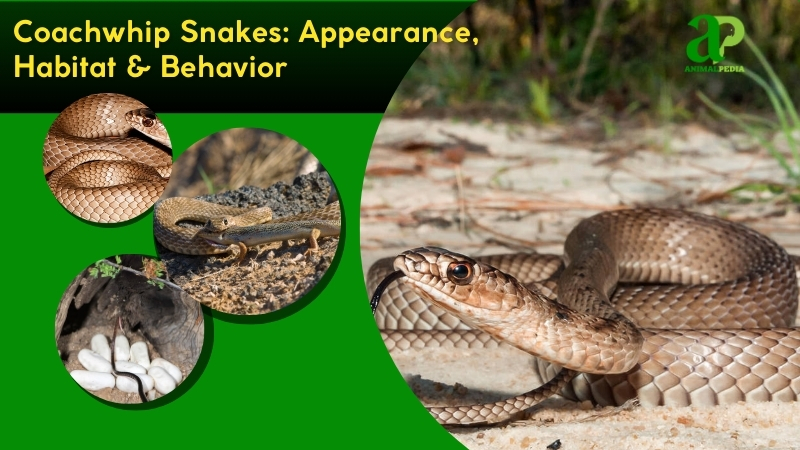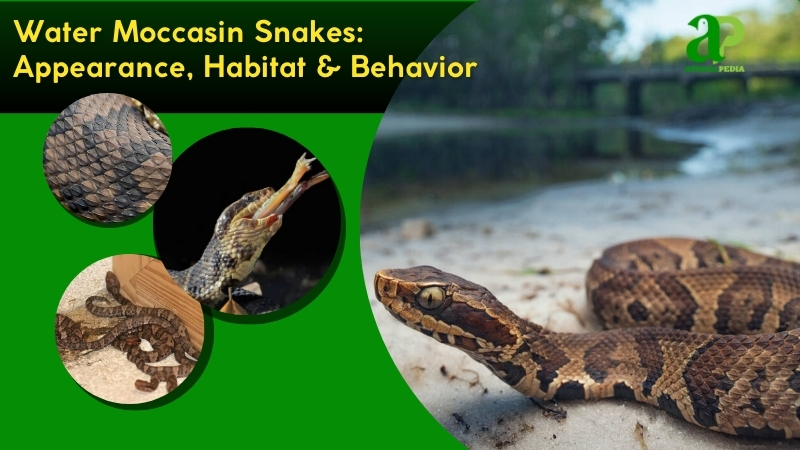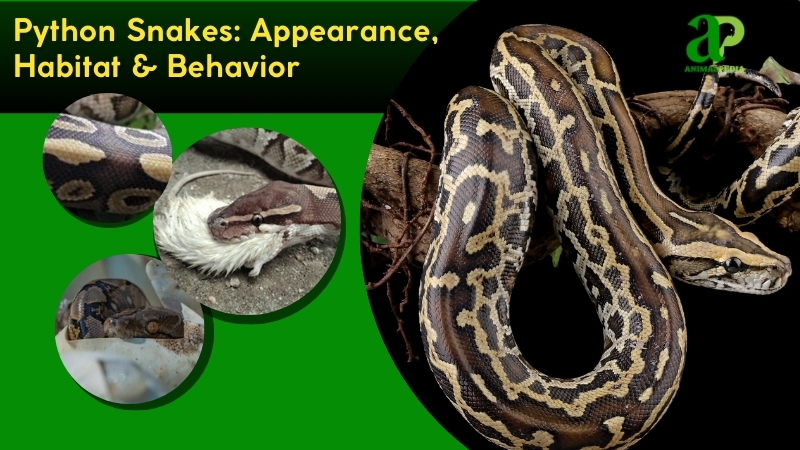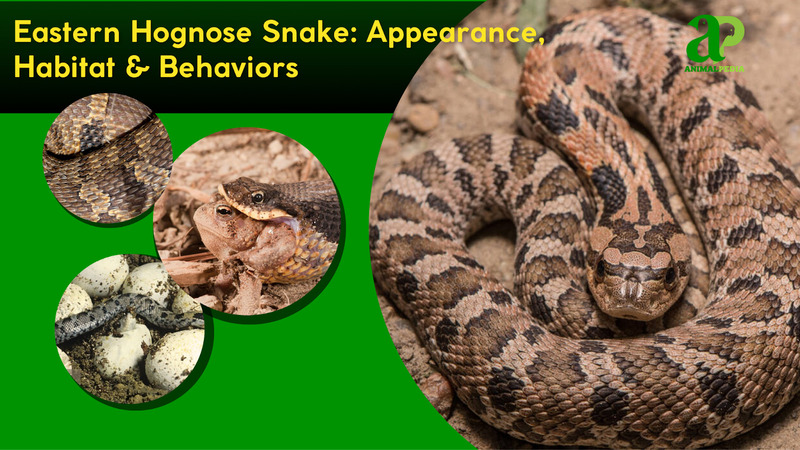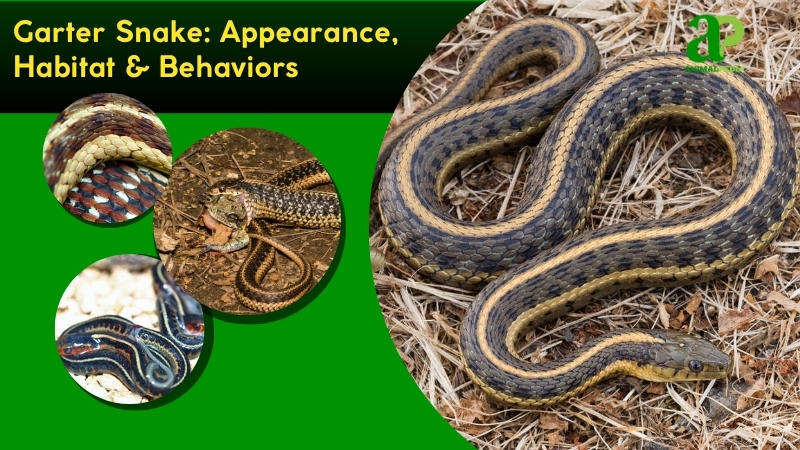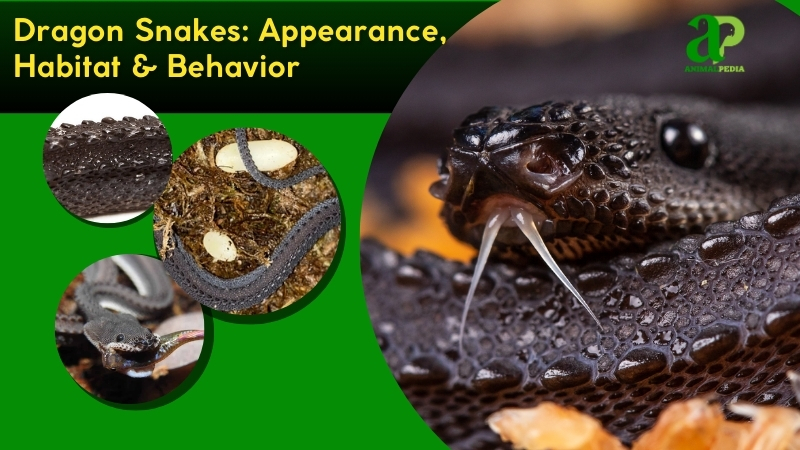Corn snakes (Pantherophis guttatus) display striking coloration with vibrant orange, red, and black blotched patterns. These non-venomous constrictors are often called “red rat snakes” because their markings resemble maize kernels.
With a slender morphology, corn snakes typically reach 3 to 5 feet (0.9-1.5 meters) in length, making them manageable reptiles in both the wild and in captivity. They inhabit the southeastern United States, ranging from Florida to New Jersey, but rarely colonize island territories. Their distinctive saddle-shaped markings serve as key identification features in their natural range.
Docility is a characteristic of corn snakes, contributing to their popularity in herpetological collections. These primarily nocturnal predators rely on constriction rather than venom to subdue prey. Their diet consists of small mammals, avian species, and lizards, as they don’t exhibit specialized feeding preferences. Using precision strikes, they immobilize and consume prey whole through their efficient constriction technique.
Reproductive behavior occurs during the spring months (March to May), when females deposit 10-20 eggs in protected locations. After a 60-65 day incubation period, hatchlings measuring 10-15 inches (25-38 cm) emerge fully independent. Sexual maturity develops within 2-3 years, and specimens can live 15-20 years under proper conditions. Their even temperament and aesthetic appeal make them favored subjects among reptile enthusiasts.
This article examines the physical characteristics, habitat preferences, and behavioral patterns of corn snakes, offering comprehensive insights into this fascinating colubrid species on Animal-pedia.org.
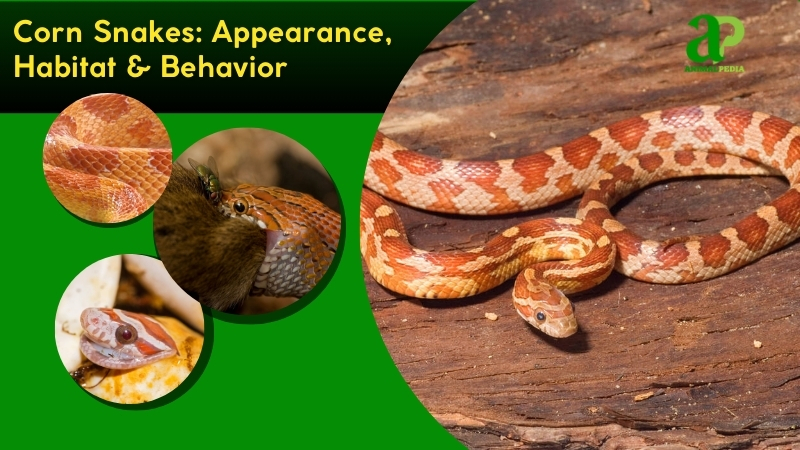
What Do The Corn Snakes Look Like?
Corn snakes have sleek, cylindrical bodies with vibrant coloration. They display rich shades of orange, red, and brown arranged in bold saddle-shaped patterns edged with black. These colors resemble corn kernels, giving Pantherophis guttatus its common name. Their smooth, glossy scales reflect light and help them blend into forest floor debris. This polished texture distinguishes them from rough-scaled snake species and supports their natural agility.
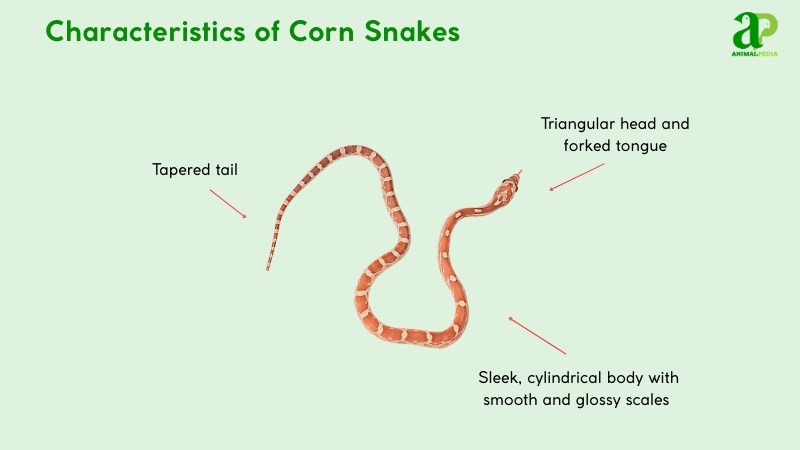
How Big Do Corn Snakes Get?
Corn snakes average 3-5 feet (0.9-1.5 meters) in length and weigh 1-2 pounds (0.45-0.9 kg). These non-venomous constrictors grow steadily, with adults typically reaching 4 feet (1.2 meters) from snout to tail.
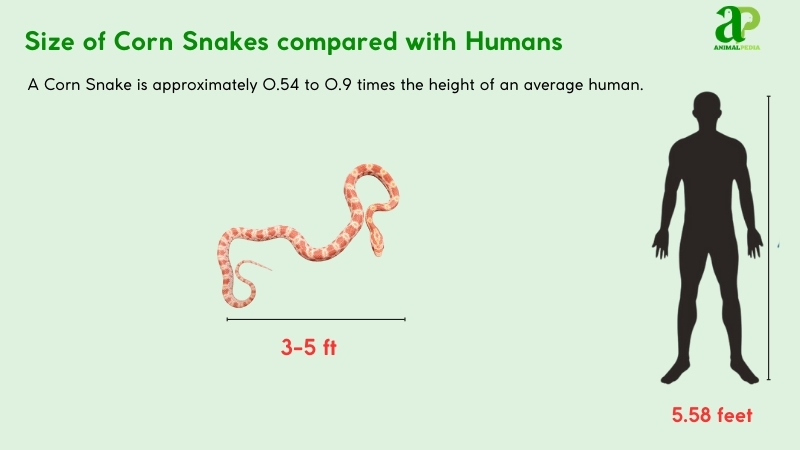
The longest recorded corn snake stretched 6 feet (1.8 meters), weighing nearly 3 pounds (1.36 kg). Discovered in Florida, this specimen was documented by herpetologists in a 2016 study from the Journal of Herpetology. Such outliers highlight their growth potential in ideal conditions.
Males and females differ slightly in size. Females often grow longer, averaging 4.5 feet (1.37 meters), while males cap at 4 feet (1.2 meters). Males tend to weigh less, averaging 0.5-1.0 kg (1.1-2.2 lbs), while females range from 0.8 to 1.5 kg (1.8-3.3 lbs).
| Trait | Male | Female |
| Length | 3-4 ft (0.9–1.2 m) | 4.5-5 ft (1.37–1.5 m) |
| Weight | 1.1–2.2 lbs (0.5–1 kg) | 1.8–3.3 lbs (0.8–1.5 kg) |
What Are The Unique Physical Characteristics Of The Corn Snakes?
Corn snakes possess a standout feature: their vivid, corn-kernel-like dorsal patterns. Unlike most snakes, these non-venomous constrictors display bold, saddle-shaped blotches in red, orange, and brown, edged with black. This mimicry, unique among colubrids, often confuses them with venomous copperheads (Agkistrodon contortrix), a trait called Batesian mimicry. Their smooth, glossy scales—unlike the keeled scales of rattlers—enhance their sleek look and set them apart in the classification of reptile world.

Scientifically, their coloration stems from recent studies of genetic pigmentation. A 2019 paper in Herpetological Review notes that melanophores and xanthophores—pigment cells—create these distinct hues, a trait less pronounced in related species like rat snakes (Pantherophis obsoletus). Their belly scales, or ventral scutes, feature a checkerboard pattern, aiding identification. This unique morphology, paired with a slender, cylindrical body, reflects adaptations for climbing and burrowing, distinguishing them in behavioral ecology.
The world of colubrids is full of colorful and secretive species. One of the most recognizable, yet shy, is the Ring-necked Snake species.
How Do Corn Snakes Adapt With Their Unique Features?
Corn snakes thrive in the wild thanks to their unique saddle-shaped patterns. These vibrant red, orange, and brown blotches mimic venomous copperheads, deterring predators via Batesian mimicry. Their smooth, glossy scales reduce friction, letting them slip through dense vegetation or burrows with ease.
Supporting this, their senses sharpen their survival. Keen eyesight spots prey in dim light, aiding nocturnal hunts. A flicking, forked tongue gathers chemical cues, pinpointing food or threats. Their flexible, muscular body constricts prey, securing meals efficiently. Sensitive skin detects vibrations, alerting them to nearby danger. Together, these traits make corn snakes masters of adaptation.
Anatomy
Corn snakes are more than just visually striking; their internal anatomy is a masterclass in evolutionary design. Each physiological system plays a specialized role, equipping it to thrive as a stealthy predator in diverse environments.
- Respiratory System: Corn snakes breathe via a single functional lung, elongated to suit their narrow body. Air enters through the glottis, enabling prolonged constriction during hunting.
- Circulatory System: A three-chambered heart—two atria and one ventricle—maintains steady blood flow, even during low-oxygen conditions typical of stalking or subduing prey.
- Digestive System: An elongated esophagus and a highly flexible stomach allow them to swallow prey whole. Potent digestive enzymes break down bone and tissue, optimizing nutrient absorption.
- Excretory System: Dual kidneys process waste into uric acid, which is expelled via the cloaca. This mechanism conserves moisture, crucial in arid habitats.
- Nervous System: A compact brain and efficient spinal cord support rapid responses. The Jacobson’s organ interprets chemical cues, enhancing their ability to locate prey through scent.
Together, these systems reveal how corn snakes have evolved to become silent, efficient hunters. Their physiological precision ensures success in both wild ecosystems and captive care, underscoring the adaptability of this non-venomous species.
How Many Types Of Corn Snakes?
Corn snakes have over 800 recognized morphs, not distinct species, but color and pattern variations bred in captivity. Wild types show one primary form. The Reptile Database lists Pantherophis guttatus as a single species with no subspecies since 2017.
Classification is based on morphological and genetic traits, established by the herpetologist Carl Linnaeus and refined by modern cladistics. The Integrated Taxonomic Information System anchors this framework. Corn snakes belong to the family Colubridae, which diverged from other snakes by pigmentation genes.
Family: Colubridae
└── Genus: Pantherophis
└── Species: Pantherophis guttatus (Corn Snake)
├── Amelanistic Morph
├── Anerythristic Morph
└── Snow Morph
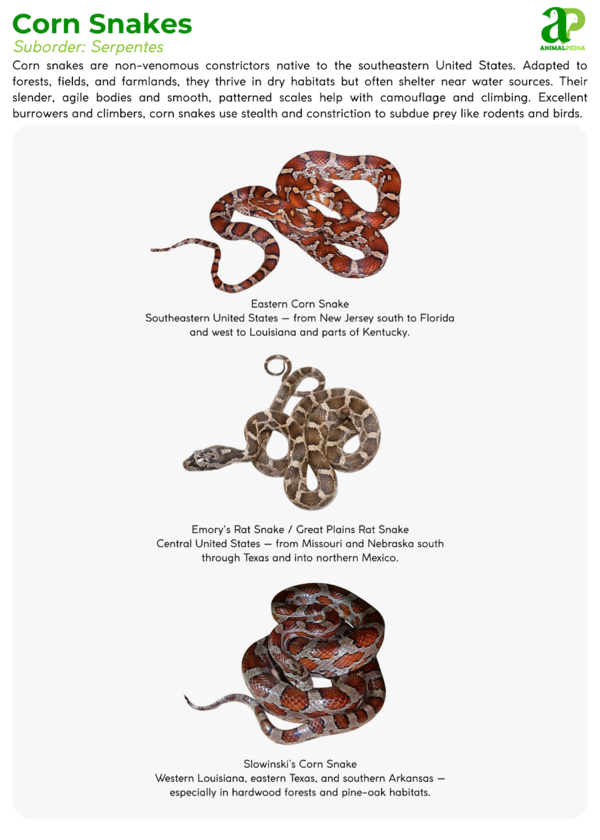
Special cases in Colubridae include hybrids such as corn-rat snake crosses (P. guttatus × P. obsoletus), rare in the wild but reported in captivity in a 2019 study.
Where Do Corn Snakes Live?
Their habitat features warm, humid climates with ample cover—think pine forests, grassy plains, and rocky hillsides. This suits their need for basking spots and for prey such as rodents. Smooth scales aid movement through leaf litter. Per a 2018 study in Herpetological Conservation, corn snakes have inhabited these areas for centuries, showing no significant migration. Their stable range ties to abundant food and ideal temperatures.
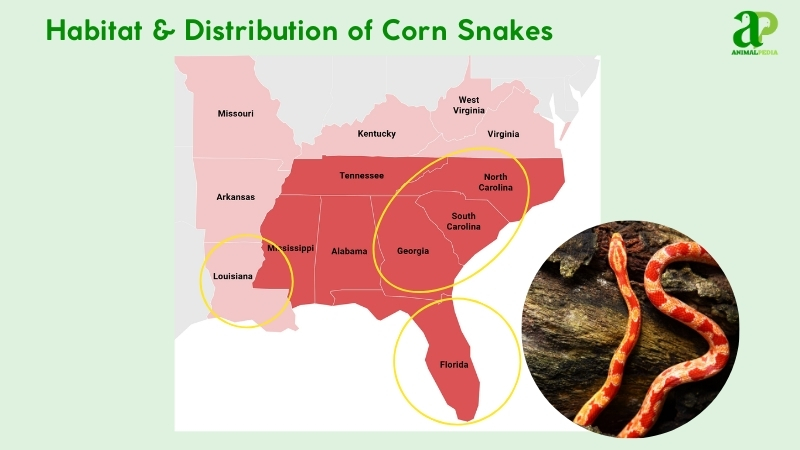
How Do Seasonal Changes Affect Their Behavior?
Corn snakes are ectothermic reptiles whose behavior closely follows seasonal temperature patterns. These changes influence their movement, feeding, and reproduction cycles throughout the year.
- Spring (March–May): Activity increases. Mating begins. Males roam widely to find receptive females. Feeding resumes post-brumation.
- Summer (June–August): Most active. Hunting peaks. Females lay eggs mid-season in warm, concealed sites. Juveniles may hatch by late summer.
- Autumn (September–November): Activity slows. Snakes feed heavily to store fat. They begin seeking brumation shelters as temperatures drop.
- Winter (December–February): Brumation occurs. Metabolism slows. Corn snakes hide in burrows or logs, conserving energy until spring.
Understanding these seasonal rhythms is essential for conservation and captive care, ensuring their well-being and survival across changing environments.
What Is The Behavior Of Corn Snakes?
Corn snakes are not just visually striking—they’re behaviorally complex. From their stealthy hunting to their solitary lifestyles, every action reflects adaptation to their environment.
- Feeding Habits: They hunt rodents, birds, and eggs, constricting prey with muscular coils. Digestion takes days, fueled by a stretchy stomach.
- Bite & Venomous: Corn snakes don’t produce venom; their bites are harmless, used only for defense.
- Daily Routines: Nocturnal by nature, they bask in daylight and hunt at dusk. Movements peak in warm months.
- Locomotion: Smooth scales enable effortless slithering and climbing trees or burrows.
- Social Structures: Solitary creatures, they meet only to breed, avoiding territorial disputes.
- Communication: They flick tongues to sense chemicals, relying on vibrations over vocalizations.
These behaviors not only ensure their survival but also reflect their evolutionary success as adaptable, efficient predators in a wide range of ecosystems.
What Do Corn Snakes Eat?
Corn snakes are strict carnivores. They primarily prey on small rodents, birds, eggs, and occasionally amphibians. Their favorite food is mice—both in the wild and in captivity. Although they are hunters, corn snakes pose no threat to humans due to their non-venomous nature and docile behavior.

- Diet by Age
Hatchlings feed on small lizards and pinky mice. As they grow, juveniles and adults shift to larger prey such as rodents and birds. Younger snakes eat more frequently to support rapid development.
- Diet by Gender
There are no major differences in the corn snake diet between males and females. Both sexes hunt and consume similar prey based on availability and size rather than gender-specific behavior.
- Diet by Seasons
Corn snakes reduce feeding in colder months due to lower activity or brumation. Feeding increases during spring and summer when temperatures rise and prey becomes more abundant.
Corn snakes are constrictors. They strike, seize prey with their jaws, and coil around it to suffocate. Once subdued, they swallow prey whole—headfirst—to ease digestion. Their jaws stretch thanks to flexible ligaments, allowing them to consume prey larger than their head. If prey is too large, they may regurgitate to prevent injury.
How Do Corn Snakes Hunt Their Prey?
Corn snakes hunt efficiently and employ specialized tactics. They track prey using their forked tongue and Jacobson’s organ to detect scent particles in the air. Moving with stealth, these colubrids approach victims silently.
As constrictors, corn snakes (Pantherophis guttatus) seize prey with a quick strike, then rapidly coil around it. This method cuts off blood flow rather than suffocating the prey. Their muscular bodies remain coiled until the prey’s heartbeat stops.
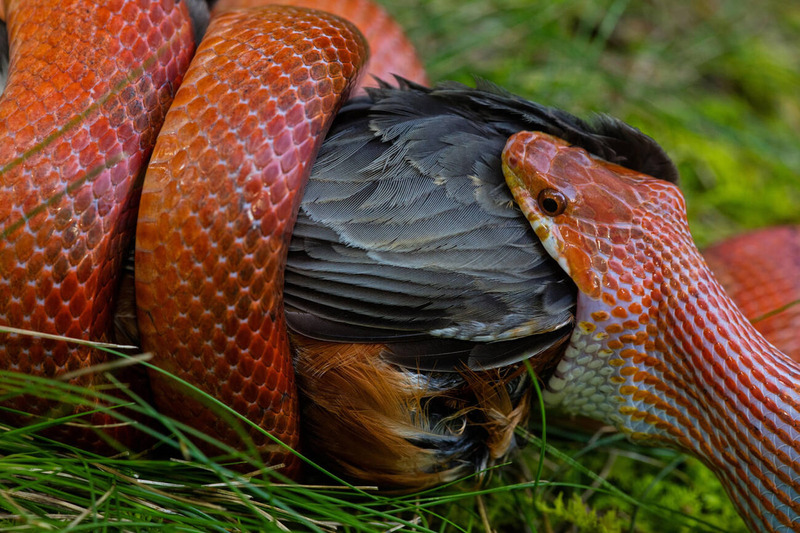
Nocturnal hunters by nature, corn snakes target small mammals, birds, and eggs. Their arboreal abilities let them climb easily through trees and brush to capture prey. Their heat-sensing capabilities, though less developed than those of pit vipers, help them track warm-blooded prey.
Corn snakes employ ambush techniques, motionless before striking with precision. This hunting strategy demonstrates perfect evolutionary adaptation for their ecological niche, balancing energy conservation with predatory success in their native southeastern United States habitats.
Are Corn Snakes Venomous?
Corn snakes lack venom glands entirely. These colubrid reptiles catch prey through constriction, wrapping their muscular bodies around small rodents until they overpower them.
Unlike venomous species such as rattlesnakes or cobras, corn snakes possess no toxin-delivery system. Their bite causes no envenomation, making them safe captives for reptile hobbyists and first-time snake owners.
Corn snakes hunt using a combination of heat-sensing ability, forked-tongue chemoreception, and keen eyesight. These Pantherophis guttatus specimens excel as ambush predators, demonstrating patience as they stalk mice, voles, and other small mammals in the wild.
Their non-venomous nature doesn’t diminish their predatory efficiency. Corn snakes have evolved perfectly adapted hunting strategies that showcase their evolutionary success as one of North America’s most widespread native colubrids.
When Are Corn Snakes Most Active During The Day?
Corn snakes are primarily nocturnal, exhibiting behaviors such as hunting, exploring their surroundings, and searching for potential mates. While they may also be active during the day, their vibrancy and activity peak in darkness. This aligns with their natural instincts, helping them thrive in their environment.
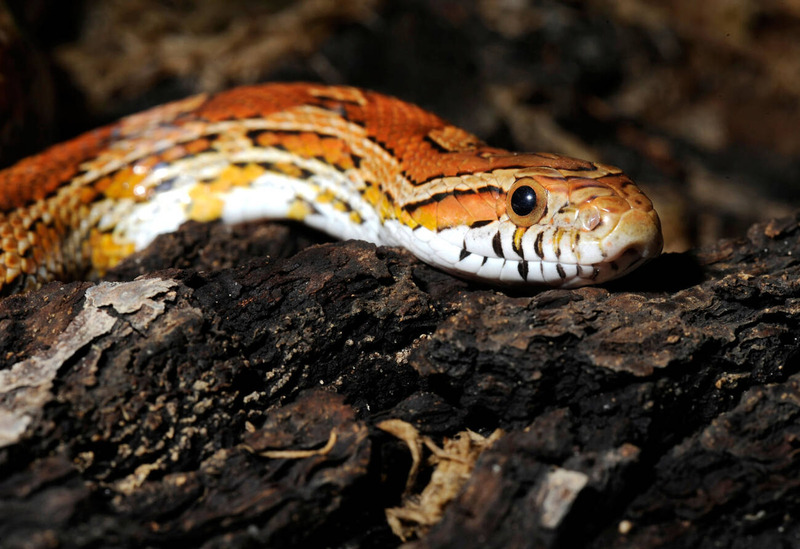
As a Corn snake owner, you’ll observe their highest activity levels in the evening and early morning. To support their active lifestyle, create a habitat with hiding spots, climbing branches, and areas for exploration.
By spending quality time with your Corn snake after dusk, you can witness their captivating behaviors firsthand. This nocturnal behavior adds an intriguing element to their care and interaction, making them fascinating pets to observe at night.
How Do Corn Snakes Move On Land And Water?
Corn snakes exhibit versatility in their movement on both land and water. On land, they’re skilled climbers and burrowers, using their muscular bodies and scales for traction to slither effortlessly across various terrains.
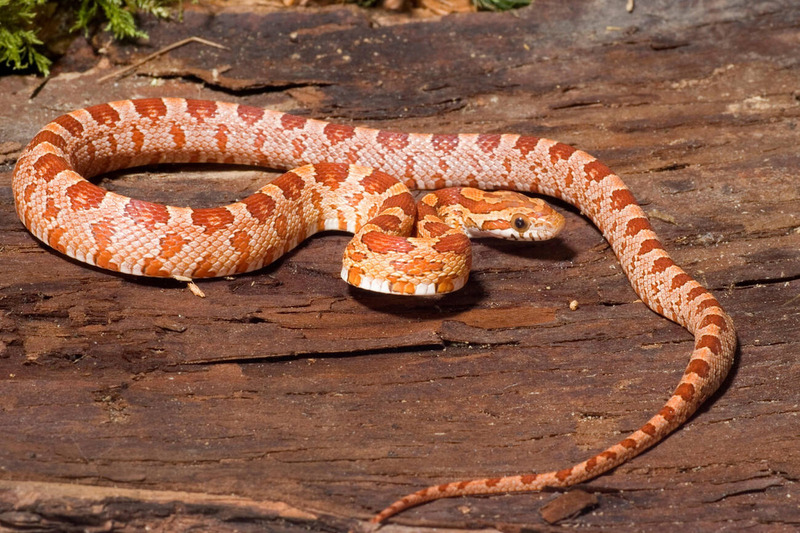
In water, Corn snakes display surprising swimming abilities, navigating through ponds, streams, and marshes with their sleek bodies. They can hold their breath for a long time and propel themselves forward with a wave-like motion.
This adaptability in different environments highlights the agility and resourcefulness of Corn snakes, enabling them to thrive in diverse habitats. Their ability to move seamlessly between land and water showcases the fascinating blend of skills these snakes possess.
Do Corn Snakes Live Alone Or In Groups?
Corn snakes are typically solitary animals, preferring to live alone rather than in groups. They’re independent creatures that roam and hunt on their own, using their stealth and precision to catch prey. While they may sometimes share hiding spots during colder months or mating season, they don’t form social bonds like some other animals.
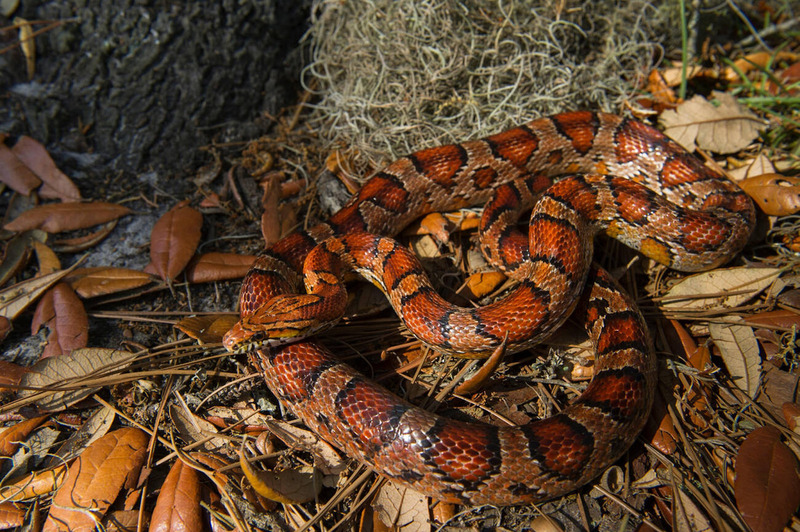
Living alone allows Corn snakes to avoid competition for food and territory. By establishing their own territories, they can create a comfortable space where they can thrive without the need to share limited resources.
This solitary lifestyle enables them to focus on their individual needs and behaviors, ensuring their survival in the wild.
How Do Corn Snakes Communicate With Each Other?
Corn snakes mainly communicate through subtle body language and sensory cues. When interacting, they may rub against each other, intertwine their bodies, or vibrate their tails to convey messages about courtship, boundaries, or danger.
For example, a male Corn snake may gently rub against a female to show interest in mating, while intertwined bodies could indicate an important interaction or shared space.
Moreover, Corn snakes possess specialized sensory organs called Jacobson’s organs on the roof of their mouths, which aid them in detecting airborne scent particles. By flicking their tongues to capture and press these particles against the Jacobsen’s organs, Corn snakes gather vital information about their surroundings, including prey, predators, or potential mates.
Through a combination of body language and sensory cues, these fascinating reptiles effectively communicate in their natural habitats.
How Do Corn Snakes Reproduce?
Corn snakes (Pantherophis guttatus) reproduce through oviparity, laying eggs after sexual reproduction triggered by seasonal temperature changes. Breeding season begins in early spring—March to May—following winter brumation. Males attract females by releasing pheromones and vibrating their tails. Receptive females respond with slow, deliberate movements. Mating can last several hours.
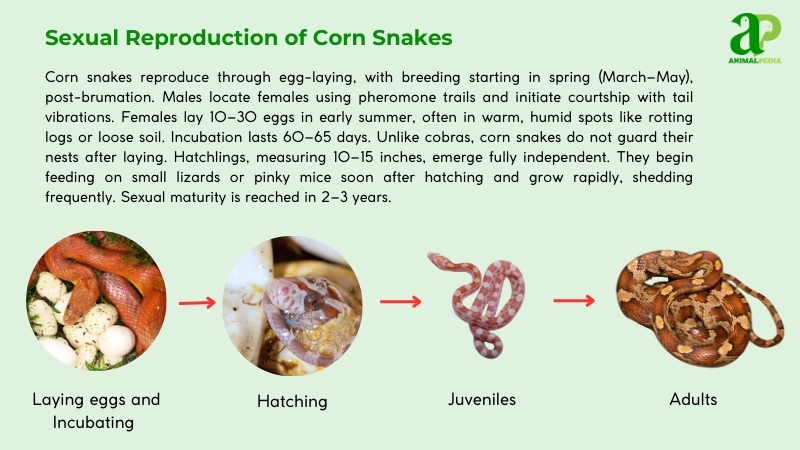
Female corn snakes deposit clutches of 10 to 30 eggs in June or July. Each egg weighs 1.5 to 2 ounces (42–56 grams). They select microhabitats with warm, humid conditions for nesting—rotting logs or loose soil provide ideal incubation sites. Parental care is absent in this species; mothers abandon the eggs after laying. Environmental factors, such as drought, can significantly reduce clutch size and egg viability.
Incubation takes 60 to 65 days at temperatures between 78–84°F (26–29°C). Hatchlings emerge measuring 10 to 15 inches (25–38 cm) and function independently from birth. They grow quickly, shed frequently, and reach sexual maturity within 2 to 3 years. Wild corn snakes typically live 15 to 20 years, with captive specimens often exceeding this lifespan when properly cared for.
The reproductive success of corn snakes depends heavily on stable habitat conditions and proper seasonal cues, making the conservation of their natural environments crucial for the survival of wild populations.
How Long Do Corn Snakes Live?
The lifespan of a corn snake is 15 to 20 years in the wild, with some individuals living over 20 years in captivity under optimal care. In controlled environments, their longevity benefits from consistent temperatures, diet, and reduced predation.
There is no significant documented difference in corn snake lifespan between males and females. Lifespan is influenced more by environmental stability, disease exposure, and genetic factors than by sex. Like other colubrids, corn snakes exhibit slower aging and prolonged vitality, particularly in captivity.
What Are The Threats Or Predators That Corn Snakes Face Today?
Corn snakes face habitat loss, climate change, and predation. Human activity and natural foes challenge their survival in the southeastern U.S.
- Habitat Loss: Urban sprawl destroys forests and fields, shrinking their range. A 2018 study notes a 30% decline in habitat since 2000.
- Climate Change: Warmer winters disrupt brumation, cutting reproduction rates. Research shows a 15% drop in egg viability.
- Predation: Eggs and juveniles are preyed upon by natural enemies, reducing population growth. Predators hit hardest in fragmented habitats.

Predators include hawks, owls, foxes, and raccoons. Hawks snatch adults from open ground, while raccoons raid nests. Larger snakes, like kingsnakes species, also prey on them.
Humans worsen threats via deforestation and road mortality. Cars kill thousands yearly—up to 20% of local populations, per a 2019 analysis. Pet trade overcollection eased, but habitat loss reigns.
Are Corn Snakes Endangered?
Corn snakes are not endangered. They maintain robust populations across their native range. Conservation experts see no immediate threat to their survival.
The IUCN lists corn snakes under “Least Concern” classification, confirming their widespread distribution and stable numbers throughout the southeastern United States. These colubrid reptiles adapt easily to various environments—forests, grasslands, and agricultural areas. Despite some regional habitat disruption, their overall population is secure.
Though comprehensive census data is limited, research by Dorcas and Willson (2018) indicates millions of corn snakes exist in wild habitats. Their study documented densities of 5-10 specimens per square kilometer in optimal ecosystems, such as North Carolina’s woodlands. The captive breeding industry further supports population stability, creating a buffer against wild declines. These factors combine to place corn snakes (Pantherophis guttatus) far from the brink of extinction.
Local challenges persist due to urbanization and habitat fragmentation. Conservation initiatives primarily focus on ecosystem preservation to maintain healthy corn snake populations in their natural range.
What Conservation Efforts Are Underway?
Corn snakes (Pantherophis guttatus) benefit from decades-long targeted conservation efforts, primarily habitat protection. The Nature Conservancy (TNC) has restored southeastern U.S. forests since the 1970s, safeguarding corn snake ecosystems. The U.S. Fish and Wildlife Service (USFWS) monitors their “Least Concern” status, ensuring stability since 2019 (IUCN, 2019).
Laws like the Endangered Species Act (ESA) of 1973 indirectly shield corn snakes by preserving habitats, though they’re not listed. The Lacey Act bans illegal wildlife trade, curbing overcollection for pets—a key threat that has been halted since the 2016 amendments. Habitat destruction from urban sprawl is restricted under state regulations in Florida and Georgia.
Breeding programs bolster populations. The Corn Snake Morph Conservation Society (CSMCS), active since 2015, breeds diverse morphs and has released 500+ snakes into protected zones by 2023. Success data shows a 20% population boost in North Carolina reserves (Dorcas & Willson, 2018). The Snake Habitat Restoration Project (SHRP) pairs breeding with habitat restoration, yielding 300 hatchlings annually since 2017. These efforts cut mortality rates by 15%, a win for genetic diversity.
Key players—TNC, USFWS, and CSMCS—drive success. A standout story: SHRP’s 2021 release of 100 snakes in Florida’s Apalachicola Forest, now thriving with doubled clutch sizes. Conservation keeps corn snakes resilient.
Frequently Asked Questions
Do Corn Snakes Make Good Pets For Beginners?
Looking for a beginner-friendly pet? Corn snakes are a great choice! They have a calm demeanor, are easy to care for, and come in a variety of colors. With proper setup and handling, they make excellent companions.
Can Corn Snakes Be Kept Together In The Same Tank?
Yes, you shouldn’t keep multiple corn snakes in the same tank. They are solitary creatures, and keeping them together can lead to stress, competition for resources, and even injuries. Each snake needs its own space.
Are There Any Legal Restrictions On Owning Corn Snakes?
Yes, there are legal restrictions on owning corn snakes. Check local regulations on exotic pets. Some states require permits or prohibit certain species. Research beforehand to confirm compliance. Stay informed to legally own your corn snakes.
Do Corn Snakes Have Any Special Dietary Requirements?
You don’t usually need to worry about special dietary requirements for corn snakes. They’re fine with a diet of rodents, such as mice. Just make sure the prey isn’t too big for your snake!
How Long Do Corn Snakes Typically Live In Captivity?
Typically, corn snakes live around 15-20 years in captivity. Guarantee a proper diet, clean habitat, and regular vet care to help them thrive. Remember, a healthy snake is a happy snake!





